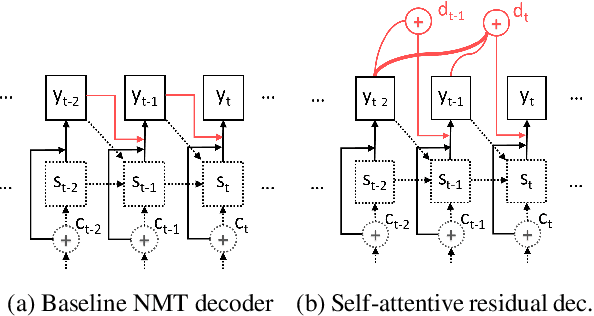Lesly Miculicich Werlen
Self-Attentive Residual Decoder for Neural Machine Translation
Oct 01, 2018



Abstract:Neural sequence-to-sequence networks with attention have achieved remarkable performance for machine translation. One of the reasons for their effectiveness is their ability to capture relevant source-side contextual information at each time-step prediction through an attention mechanism. However, the target-side context is solely based on the sequence model which, in practice, is prone to a recency bias and lacks the ability to capture effectively non-sequential dependencies among words. To address this limitation, we propose a target-side-attentive residual recurrent network for decoding, where attention over previous words contributes directly to the prediction of the next word. The residual learning facilitates the flow of information from the distant past and is able to emphasize any of the previously translated words, hence it gains access to a wider context. The proposed model outperforms a neural MT baseline as well as a memory and self-attention network on three language pairs. The analysis of the attention learned by the decoder confirms that it emphasizes a wider context, and that it captures syntactic-like structures.
Beyond Weight Tying: Learning Joint Input-Output Embeddings for Neural Machine Translation
Aug 31, 2018



Abstract:Tying the weights of the target word embeddings with the target word classifiers of neural machine translation models leads to faster training and often to better translation quality. Given the success of this parameter sharing, we investigate other forms of sharing in between no sharing and hard equality of parameters. In particular, we propose a structure-aware output layer which captures the semantic structure of the output space of words within a joint input-output embedding. The model is a generalized form of weight tying which shares parameters but allows learning a more flexible relationship with input word embeddings and allows the effective capacity of the output layer to be controlled. In addition, the model shares weights across output classifiers and translation contexts which allows it to better leverage prior knowledge about them. Our evaluation on English-to-Finnish and English-to-German datasets shows the effectiveness of the method against strong encoder-decoder baselines trained with or without weight tying.
 Add to Chrome
Add to Chrome Add to Firefox
Add to Firefox Add to Edge
Add to Edge